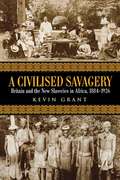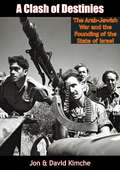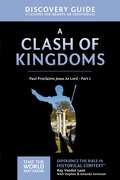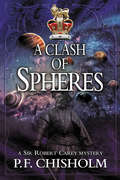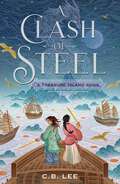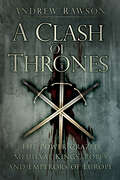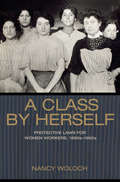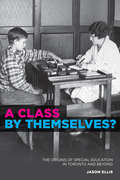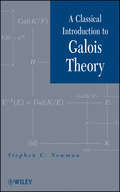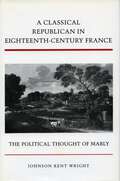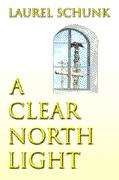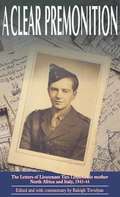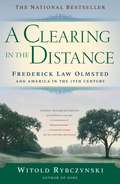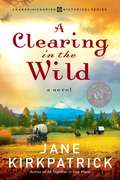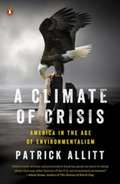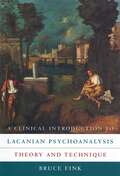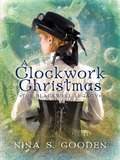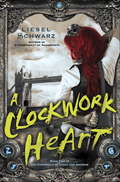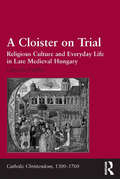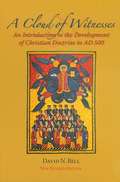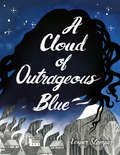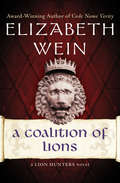- Table View
- List View
A Civil War Scrapbook: I Was There Too!
by History ColoradoA Civil War Scrapbook is a multicultural Civil War history for children. The book gives a fresh perspective on the Civil War by not only featuring chronological information, but also focusing on the different types of people and their place in the war. <P><P>This ambitious book emphasizes the roles of the children, women, minorities, and even pets that became mascots in the war. A Civil War Scrapbook is enhanced with historical photographs, drawings, maps, games, and primary quotes from children. Readers will also enjoy learning about the importance of music in the military, the advances in technology that occurred during the war, the Morse code alphabet, and slang words used during the Civil War. Online material complements the book with bonus information, games, and activities. History Colorado, the Colorado Historical Society aspires to engage people in Colorado's heritage through collecting, preserving, and discovering the past in order to educate and provide perspectives for the future. Established in 1879, History Colorado's statewide activities support tourism, historic preservation, education, and research related to Colorado's rich western history, offering the public unique opportunities to interact with Colorado history through its network of museums, which offer engaging exhibitions and special programs for adults and children. Through educational programs, History Colorado works with schools across the state to provide classrooms and teachers with important resources and curriculum related to Colorado history.
A Civilised Savagery: Britain and the New Slaveries in Africa, 1884-1926
by Kevin GrantIn the two decades before World War One, Great Britain witnessed the largest revival of anti-slavery protest since the legendary age of emancipation in the mid-nineteenth century. Rather than campaigning against the trans-Atlantic slave trade, these latter-day abolitionists focused on the so-called 'new slaveries' of European imperialism in Africa, condemning coercive systems of labor taxation and indentured servitude, as well as evidence of atrocities. A Civilized Savagery illuminates the multifaceted nature of British humanitarianism by juxtaposing campaigns against different forms of imperial labor exploitation in three separate areas: the Congo Free State, South Africa, and Portuguese West Africa. In doing so, Kevin Grant points out how this new type of humanitarianism influenced the transition from Empire to international government and the advent of universal human rights in subsequent decades.
A Clash of Cultures: Fort Bowie and the Chiricahua Apaches
by Robert M. UtleyRelates the history of the Apache Indians and of the Apache Wars of the 1800's. The Apache Wars ended with the surrender of their leader Geronimo. The parts played by Apaches Geronimo and Cochise, United States Army officers, Oliver Otis Howard, George Crook, and Nelson A. Miles, and many others are given in the narrative. Today the ruins of Fort Bowie, Arizona, stand as a monument commemorating the struggle of the Indians to maintain their way of life in the face of the white man's determination to conquer the wilderness.
A Clash of Destinies: The Arab-Jewish War and the Founding of the State of Israel
by Jon Kimche David KimcheFounded on a vast amount of research and personal interviews, as well as direct involvement in the Palestine War (1947-1948), the authors have written a book on this much disputed subject which presents a few new theories and outlooks.With minute detail, they treat and trace the history, preambles, development, and actualities of the war, and include several maps of the strategic areas and manoeuvres of the battles. Pinpointing the central and most significant personalities of the war, this is a book which should and will find a great reading audience all over the world.
A Clash of Kingdoms Discovery Guide: Paul Proclaims Jesus As Lord – Part 1 (That the World May Know #15)
by Ray Vander LaanHow do we as Christians proclaim God's name in all the earth in the midst of false gospels?Learn from the Apostle Paul as he communicated the Good News of Christ to Philippi, a Roman colony that worshipped false gods. In this fifteenth volume of the That The World May Know series, take a tour through the land of the Bible and discover how to live in your present-day Philippi or Delphi—a dechristianized Western world—in a way that keeps your citizenship in God's Kingdom.This discovery guide includes passages of Scripture explored in the DVD (sold separately); questions for discussion and personal reflection; personal Bible studies to help you deepen your learning experience between sessions; as well as sidebars, maps, photos, and other study tools.The Gospel of CaesarThe BelieversThe Powers of DarknessThe Philippian JailerConfronting the EmpireDesigned for use with A Clash of Kingdoms Video Study (sold separately)._______________THAT THE WORLD MAY KNOWJoin renowned teacher and historian Ray Vander Laan as he guides you through the land of the Bible. In each lesson, Vander Laan illuminates the historical, geographical, and cultural context of the sacred Scriptures.Filmed on location in the Middle East and elsewhere, the That the World May Know film series will transform your understanding of God and challenge you to be a true follower of Jesus.
A Clash of Spheres (Sir Robert Carey Series #8)
by P F ChisholmIt's late August, 1592. Sir Robert Carey, cousin to Queen Elizabeth from the wrong side of Henry VIII's blanket, remains at his post on the Borders at Carlisle. He has at last been confirmed by his monarch as Deputy Warden, is still deeply in love with Lady Elizabeth Widdrington while despising her elderly, abusive husband (will the man never die?). And he remains estranged from his dour but lethal henchman, Henry Dodd, Land-Sergeant of Gilsland, who is currently serving as one of the sergeants of the Carlisle Castle guard. Dodd can't forgive Carey for taking the high road at the conclusion of the incident at Dick of Dryhope's tower, when Sir Robert called out the Carlisle garrison, but "honourably and skillfully avoided the bloody-pitched battle" that seemed inevitable. Dodd is old-school and would have preferred to exterminate as many under Wee Colin Elliott, and also Grahams, as he could. Not for him, but for peace to the Debatable Land. Sir Robert Cecil, Privy Councillor to the Queen, warns of a new challenge: the King of Spain's "intentions in Scotland." Will Cecil be sending a pursuivant to the Borders to suss out, and possibly interrupt, whatever plots are in progress against England? Now it's Autumn. We meet Marguerite, an over-sexed and unhappy wife. Father Crichton, a Jesuit, formerly of Spain. A man who says his name is Jonathan Hepburn but, curiously, thinks in Deutsch. Marguerite's elderly husband Sir David, a Groom of King James' VI's Bedchamber, a jealous man. Various disloyal Scottish Earls. Janet Dodd, wife to Henry, who learns an interesting thing from Mrs. Hogg, the midwife. Hughie Tyndale, a would-be-assassin. Mr. John Napier, a philosopher and mathematician with a revolutionary theory of how the solar system works. Mr. Simon Anricks, a toothdrawer (and philosopher, too) bearing a secret letter from England, who becomes delighted with Mr. Napier. Queen Anne (of Denmark), not yet a mother. And King James, not your usual monarch, plus his court, sycophants, and (former) lover Lord Spynie, who is still plotting revenge. So many spheres of influence or disruption in play. Events come to a head at the King's court in Edinburgh where a great Disputation on the differences between the Ptolemaic and the Copernican systems, and a demonstration of the planets will be staged, a clash of spheres mirroring the same at the human level.
A Clash of Steel: A Treasure Island Remix (Remixed Classics #1)
by C. B. LeeTwo intrepid girls hunt for a legendary treasure on the deadly high seas in this YA remix of the classic adventure novel Treasure Island. <p><p> 1826. The sun is setting on the golden age of piracy, and the legendary Dragon Fleet, the scourge of the South China Sea, is no more. Its ruthless leader, a woman known only as the Head of the Dragon, is now only a story, like the ones Xiang has grown up with all her life. She desperately wants to prove her worth, especially to her mother, a shrewd businesswoman who never seems to have enough time for Xiang. Her father is also only a story, dead at sea before Xiang was born. Her single memento of him is a pendant she always wears, a simple but plain piece of gold jewelry. But the pendant's true nature is revealed when a mysterious girl named Anh steals it, only to return it to Xiang in exchange for her help in decoding the tiny map scroll hidden inside. The revelation that Xiang's father sailed with the Dragon Fleet and tucked away this secret changes everything. Rumor has it that the legendary Head of the Dragon had one last treasure—the plunder of a thousand ports—that for decades has only been a myth, a fool's journey. <p><p> Xiang is convinced this map could lead to the fabled treasure. Captivated with the thrill of adventure, she joins Anh and her motley crew off in pursuit of the island. But the girls soon find that the sea—and especially those who sail it—are far more dangerous than the legends led them to believe.
A Clash of Thrones: The Power-crazed Medieval Kings, Popes and Emperors of Europe
by Andrew RawsonMedieval Europe is a dark and dangerous place. In 1054 the Church tears itself in two, setting the scene for nearly 500 years of turmoil. Empires will collide and dynasties will rise and fall; marriages will be made and alliances broken. It is a place where love clashes with ambition and violence rules – enemies are blinded, rivals are murdered and heretics are burnt at the stake. As the Black Death sweeps the continent and the Mongol hordes threaten its borders, can the kings of the old world survive the dawn of a new era?
A Class by Herself: Protective Laws for Women Workers, 1890s-1990s
by Nancy WolochA Class by Herself explores the historical role and influence of protective legislation for American women workers, both as a step toward modern labor standards and as a barrier to equal rights. Spanning the twentieth century, the book tracks the rise and fall of women-only state protective laws--such as maximum hour laws, minimum wage laws, and night work laws--from their roots in progressive reform through the passage of New Deal labor law to the feminist attack on single-sex protective laws in the 1960s and 1970s. Nancy Woloch considers the network of institutions that promoted women-only protective laws, such as the National Consumers' League and the federal Women's Bureau; the global context in which the laws arose; the challenges that proponents faced; the rationales they espoused; the opposition that evolved; the impact of protective laws in ever-changing circumstances; and their dismantling in the wake of Title VII of the Civil Rights Act of 1964. Above all, Woloch examines the constitutional conversation that the laws provoked--the debates that arose in the courts and in the women's movement. Protective laws set precedents that led to the Fair Labor Standards Act of 1938 and to current labor law; they also sustained a tradition of gendered law that abridged citizenship and impeded equality for much of the century. Drawing on decades of scholarship, institutional and legal records, and personal accounts, A Class by Herself sets forth a new narrative about the tensions inherent in women-only protective labor laws and their consequences.
A Class by Themselves?: The Origins of Special Education in Toronto and Beyond
by Jason EllisIn A Class by Themselves?, Jason Ellis provides an erudite and balanced history of special needs education, an early twentieth century educational innovation that continues to polarize school communities across Canada, the United States, and beyond. Ellis situates the evolution of this educational innovation in its proper historical context to explore the rise of intelligence testing, the decline of child labour and rise of vocational guidance, emerging trends in mental hygiene and child psychology, and the implementation of a new progressive curriculum. At the core of this study are the students. This book is the first to draw deeply on rich archival sources, including 1000 pupil records of young people with learning difficulties, who attended public schools between 1918 and 1945. Ellis uses these records to retell individual stories that illuminate how disability filtered down through the school system’s many nooks and crannies to mark disabled students as different from (and often inferior to) other school children. A Class by Themselves? sheds new light on these and other issues by bringing special education’s curious past to bear on its constantly contested present.
A Classical Introduction to Galois Theory
by Stephen C. NewmanExplore the foundations and modern applications of Galois theory Galois theory is widely regarded as one of the most elegant areas of mathematics. A Classical Introduction to Galois Theory develops the topic from a historical perspective, with an emphasis on the solvability of polynomials by radicals. The book provides a gradual transition from the computational methods typical of early literature on the subject to the more abstract approach that characterizes most contemporary expositions. The author provides an easily-accessible presentation of fundamental notions such as roots of unity, minimal polynomials, primitive elements, radical extensions, fixed fields, groups of automorphisms, and solvable series. As a result, their role in modern treatments of Galois theory is clearly illuminated for readers. Classical theorems by Abel, Galois, Gauss, Kronecker, Lagrange, and Ruffini are presented, and the power of Galois theory as both a theoretical and computational tool is illustrated through: A study of the solvability of polynomials of prime degree Development of the theory of periods of roots of unity Derivation of the classical formulas for solving general quadratic, cubic, and quartic polynomials by radicals Throughout the book, key theorems are proved in two ways, once using a classical approach and then again utilizing modern methods. Numerous worked examples showcase the discussed techniques, and background material on groups and fields is provided, supplying readers with a self-contained discussion of the topic. A Classical Introduction to Galois Theory is an excellent resource for courses on abstract algebra at the upper-undergraduate level. The book is also appealing to anyone interested in understanding the origins of Galois theory, why it was created, and how it has evolved into the discipline it is today.
A Classical Republican in Eighteenth-Century France: The Political Thought of Mably
by Johnson WrightThis is an intellectual biography of Gabriel Bonnot de Mably (1709-85), who emerges as a central figure in the history of republican thought in the era of the Enlightenment and the French Revolution. This book has two related aims. The first is to fill an important gap in historical scholarship. Although Mably, whose career as a historian and political theorist stretched from 1740 to the eve of the French Revolution, clearly played a major role in the intellectual history of his era, there has been no study of his life and thought in English for nearly seventy years. At the same time, the book seeks to advance a novel interpretation of Mably's thought. He has most often been portrayed in two sharply contrasted ways, either as one of a handful of utopian communists and a precursor of nineteenth-century socialism, or as a deeply conservative enemy of the Enlightenment. This study sets forth a different reading of Mably's thought, one that shows him to be a classical republican, in the sense this term has acquired in recent years for students of early modern political thought. Mably was the author of the most comprehensive and influential body of republican thought produced in eighteenth-century France--a claim with implications that go beyond the merely biographical. These are explored in a final chapter, which draws some conclusions about the character of classical republicanism in France and about the French contribution to the republican tradition in Europe.
A Clear North Light: Book One of the Lithuanian Trilogy
by Laurel SchunkPetras Simonaitis, a young Lithuanian artisan struggling to support his mother and sister, faces the impossible task of coming into manhood under first Nazi and then Soviet domination. Baron Pavel Gerulaitis, a Nazi sympathizer and rich landowner, desires to sire Aryan children although he has dark hair and eyes. When the Baron convinces Petras's sister Ona to live at his castle and be groomed as his future wife, Petras feels powerless to save her. The Baron's first wife and child - a dark child - die mysteriously. Then Ona's body is found floating in the river - at the hands of the Baron, Petras believes. Petras is a Protestant - in a Catholic country - struggling with his faith. He is friends with Joelis, a young Jew, in spite of the taboo against such friendships. Joelis tries to convince Petras and his friend Kazys to help form labor unions to strengthen the country against the rise of communism, but Kazys sneers at their idealism and Petras becomes too overwhelmed with the threats to his loved ones' lives to fight for unions. Rima, the young woman Petras loves, also disappears into the Baron's castle. Rima becomes pregnant with the Baron's child, but Petras marries her and they flee giauliai. Rima begins her lifelong struggle with depression, yet for a short time they live a quiet idyll in the forest of Birai, until the child Gintaras is born and the Baron and the Nazis intrude upon them.
A Clear Premonition: The Letters of Lieutenant Tim Lloyd To His Mother, North Africa and Italy, 1943-44
by Raleigh TrevelyanAn insightful collection of WWII correspondence between a British lieutenant & his mother, with commentary by his best friend and fellow soldier. Tim Lloyd was aged twenty-two, a lieutenant in the Rifle Brigade, when he was killed in action near Florence in July, 1944. His personality made a vivid impression on his companions, and after all these years he is remembered still for his extraordinary zest for life, his indomitable cheerfulness, and his appreciation of beautiful things. If he had lived, he might well have joined the famous publishing firm of his brother-in-law, Sir William Collins, but more likely he would have been a theatre designer, possibly a great one. He was also brave, though his period at the front line was brief. Raleigh Trevelyan, a year younger, regarded him as his best friend. It was a shock when Tim's nephew Samson Lloyd showed Raleigh Tim&’s letters to his mother when they were together in North Africa and Italy. For the first time, Raleigh reread extracts from his own diary and found himself plunged into memories he hoped he had put to rest. Tim had been ill in Italy, so missed being sent to Anzio Beachhead, the subject of Raleigh&’s much praised and harrowing battle memoir The Fortress, and also part of his later book Rome &‘44. Meanwhile Tim continued his letters to his mother, outstanding not only in their descriptions of landscape and people, but as an example of a son's deep devotion. Sue Ryder, who had first met Tim on the boat to South Africa, was convinced that he had a clear premonition of what lay in store. Based on his letters to Mrs. Lloyd, the book traces his childhood at Repton, his passion for the theatre and his marionette shows in ENSA, also life in the ranks and wild times in London after being commissioned.
A Clearing In The Distance: Frederick Law Olmsted and America in the 19th Century
by Witold RybczynskiIn a brilliant collaboration between writer and subject, Witold Rybczynski, the bestselling author of Home and City Life, illuminates Frederick Law Olmsted's role as a major cultural figure at the epicenter of nineteenth-century American history.We know Olmsted through the physical legacy of his stunning landscapes -- among them, New York's Central Park, California's Stanford University campus, and Boston's Back Bay Fens. But Olmsted's contemporaries knew a man of even more extraordinarily diverse talents. Born in 1822, he traveled to China on a merchant ship at the age of twenty-one. He cofounded The Nation magazine and was an early voice against slavery. He managed California's largest gold mine and, during the Civil War, served as the executive secretary to the United States Sanitary Commission, the precursor of the Red Cross. Rybczynski's passion for his subject and his understanding of Olmsted's immense complexity and accomplishments make his book a triumphant work. In A Clearing in the Distance, the story of a great nineteenth-century American becomes an intellectual adventure.
A Clearing in the Wild (Change and Cherish #1)
by Jane KirkpatrickYoung Emma Wagner chafes at the constraints of Bethel colony, an 1850s religious community in Missouri that is determined to remain untainted by the concerns of the world. A passionate and independent thinker, she resents the limitations placed on women, who are expected to serve in quiet submission. In a community where dissent of any form is discouraged, Emma finds it difficult to rein in her tongue-and often doesn't even try to do so, fueling the animosity between her and the colony's charismatic and increasingly autocratic leader, Wilhelm Keil. Eventually Emma and her husband, Christian, are sent along with eight other men to scout out a new location in the northwest where the Bethelites can prepare to await "the last days." Christian believes they've found the ideal situation in Washington territory, but when Keil arrives with the rest of the community, he rejects Christian's choice in favor of moving to Oregon. Emma pushes her husband to take this opportunity to break away from the group, but her longed-for influence brings unexpected consequences. As she seeks a refuge for her wounded faith, she learns that her passionate nature can be her greatest strength-if she can harness it effectively.From the Trade Paperback edition.
A Climate of Crisis
by Patrick AllittA provocative history of the environmental movement in America, showing how this rise to political and social prominence produced a culture of alarmism that has often distorted the facts Few issues today excite more passion or alarm than the specter of climate change. In A Climate of Crisis, historian Patrick Allitt shows that our present climate of crisis is far from exceptional. Indeed, the environmental debates of the last half century are defined by exaggeration and fearmongering from all sides, often at the expense of the facts. In a real sense, Allitt shows us, collective anxiety about widespread environmental danger began with the atomic bomb. As postwar suburbanization transformed the American landscape, more research and better tools for measurement began to reveal the consequences of economic success. A climate of anxiety became a climate of alarm, often at odds with reality. the sixties generation transformed environmentalism from a set of special interests into a mass movement. by the first Earth Day in 1970, journalists and politicians alike were urging major initiatives to remedy environmental harm. In fact, the work of the new Environmental Protection Agency and a series of clean air and water acts from a responsive Congress inaugurated a largely successful cleanup. Political polarization around environmental questions after 1980 had consequences that we still feel today. Since then, the general polarization of American politics has mirrored that of environmental politics, as pro-environmentalists and their critics attribute to one another the worst possible motives. Environmentalists see their critics as greedy special interest groups that show no conscience as they plunder the earth while skeptics see their adversaries as enemies of economic growth whose plans stifle initiative under an avalanche of bureaucratic regulation. There may be a germ of truth in both views, but more than a germ of falsehood too. America's worst environmental problems have proven to be manageable; the regulations and cleanups of the last sixty years have often worked, and science and technology have continued to improve industrial efficiency. Our present situation is serious, argues Allitt, but it is far from hopeless. Sweeping and provocative, A Climate of Crisis challenges our basic assumptions about the environment, no matter where we fall along the spectrum--reminding us that the answers to our most pressing questions are sometimes found in understanding the past.
A Climate of Crisis: America in the Age of Environmentalism
by Patrick AllittA provocative history of the environmental movement in America, showing how this rise to political and social prominence produced a culture of alarmism that has often distorted the factsFew issues today excite more passion or alarm than the specter of climate change. In A Climate of Crisis, historian Patrick Allitt shows that our present climate of crisis is far from exceptional. Indeed, the environmental debates of the last half century are defined by exaggeration and fearmongering from all sides, often at the expense of the facts. In a real sense, Allitt shows us, collective anxiety about widespread environmental danger began with the atomic bomb. As postwar suburbanization transformed the American landscape, more research and better tools for measurement began to reveal the consequences of economic success. A climate of anxiety became a climate of alarm, often at odds with reality. The sixties generation transformed environmentalism from a set of special interests into a mass movement. By the first Earth Day in 1970, journalists and politicians alike were urging major initiatives to remedy environmental harm. In fact, the work of the new Environmental Protection Agency and a series of clean air and water acts from a responsive Congress inaugurated a largely successful cleanup. Political polarization around environmental questions after 1980 had consequences that we still feel today. Since then, the general polarization of American politics has mirrored that of environmental politics, as pro-environmentalists and their critics attribute to one another the worst possible motives. Environmentalists see their critics as greedy special interest groups that show no conscience as they plunder the earth while skeptics see their adversaries as enemies of economic growth whose plans stifle initiative under an avalanche of bureaucratic regulation. There may be a germ of truth in both views, but more than a germ of falsehood too. America’s worst environmental problems have proven to be manageable; the regulations and cleanups of the last sixty years have often worked, and science and technology have continued to improve industrial efficiency. Our present situation is serious, argues Allitt, but it is far from hopeless. Sweeping and provocative, A Climate of Crisis challenges our basic assumptions about the environment, no matter where we fall along the spectrum—reminding us that the answers to our most pressing questions are sometimes found in understanding the past.From the Trade Paperback edition.
A Clinical Introduction to Lacanian Psychoanalysis: Theory and Technique
by Bruce FinkArguably the most profound psychoanalytic thinker since Freud, and deeply influential in many fields, Jacques Lacan often seems opaque to those he most wanted to reach. These are the readers Bruce Fink addresses in this clear and practical account of Lacan's highly original approach to therapy. Written by a clinician for clinicians, Fink's introduction is an invaluable guide to Lacanian psychoanalysis, how it's done, and how it differs from other forms of therapy. While elucidating many of Lacan's theoretical notions, the book does so from the perspective of the practitioner faced with the pressing questions of diagnosis, which therapeutic stance to adopt, how to involve the patient, and how to bring about change.
A Clockwork Christmas
by Nina S. GoodenOlyve Blackwell is done playing by the rules. With rumors of sorcery and danger shrouding her family, not even the whispers of Revolution can distract from her unwedable status. So, when a desperate woman hands her a questionable item and begs for her help, she decides to shatter the chains of propriety. Armed with the supernatural gift of psychometry, she delves into a life of sleuthing. With Christmas on the way, she buries herself in a kidnapping case with deep roots in the ton. Her efforts to escape the loneliest holiday of the year bring her head to head with a mysterious stranger who may just be her most treacherous enemy...or the answer to her heart's deepest desires. When the call of her Intuition screams his name, Olyve will have to decide whether or not she will trust James Reeves. With betrayal lurking at every corner, one slip could destroy her and unleash the deadly potential hidden within.
A Clockwork Heart
by Liesel SchwarzFOR BETTER OR CURSE. That might as well have been the wedding vow of Elle Chance and her new husband, the ex-Warlock Hugh Marsh in the second book of this edgy new series that transforms elements of urban fantasy, historical adventure, and paranormal romance into storytelling magic. As Elle devotes herself to her duties as the Oracle--who alone has the power to keep the dark designs of Shadow at bay--Marsh finds himself missing the excitement of his former life as a Warlock. So when Commissioner Willoughby of the London Metropolitan police seeks his help in solving a magical mystery, Marsh is only too happy to oblige. But in doing so, Marsh loses his heart . . . literally. In place of the flesh-and-blood organ is a clockwork device--a device that makes Marsh a kind of zombie. Nor is he the only one. A plague of clockwork zombies is afflicting London, sowing panic and whispers of revolution. Now Elle must join forces with her husband's old friend, the Nightwalker Loisa Beladodia, to track down Marsh's heart and restore it to his chest before time runs out.From the Hardcover edition.
A Cloister on Trial: Religious Culture and Everyday Life in Late Medieval Hungary (Catholic Christendom, 1300-1700)
by Gabriella ErdélyiIn 1517, the usually tranquil friary in the Hungarian town of Körmend found itself at the centre of controversy when its Augustinian friars, charged with drunkenness, sexual abuses and liturgical negligence, were driven out and replaced with observant Franciscans. The agent of change in this conflict, cardinal Thomas Bakócz, claimed to be acting in the name of ’cloister reform’ motivated by a religious agenda, while the Augustinians portrayed themselves as the victims of a political game. Based on the surviving interrogations of a papal enquiry into these events, this book illuminates the tensions and potential conflict that lurked within the religious culture of a seemingly unremarkable and remote town. The story of the friary trial of Körmend provides a fascinating window into religion and society of Europe at the dawn of the Reformation, investigating the processes by which ordinary people emerge as historical agents from the written records. By focussing on their experiences as represented in the trial documents the book reveals the spaces and borders of individual and communal action within the dynamic of lay-clerical relations negotiated in a friary reform at the beginning of the 16th century. Furthermore, the moral nature of the accusations levelled at the Augustinians - and whether these were justified or instigated for political reasons - offers further insights into the nature of late-medieval Catholicism and the claims of Protestant reformers.
A Cloud Of Witnesses: An Introductory History of the Development of Christian Doctrine to 500 AD, New Revised Edition
by David N. BellA Cloud of Witnesses has been completely rewritten to incorporate a multitude of minor amendments and a considerable amount of additional information. Like the first edition, it is intended as an introduction to the formative first five hundred years of the Christian theological tradition. In these pages the opinions and personalities of the Fathers of the Church that emerge are presented against the intellectual, social, and political world of their times, but since the book is only an introduction, the author presents the development of Christian doctrine in a rather more logical and cohesive manner than was the case in reality.
A Cloud of Outrageous Blue
by Vesper StamperFor fans of Fever 1793 comes the story of a young woman paving her own path and falling in love during the Great Plague of 1348, from the award-winning creator of What the Night Sings.Edyth grew up in a quiet village with a loving family, before losing everything she holds dear in the blink of an eye. Suddenly sent to live in a priory and work with ancient texts, Edyth must come to terms with her new life and the gifts she discovers in herself. But outside the priory, something much worse is coming. With the reappearance of a boy from her past and the ominous Great Plague creeping closer and closer to the priory, it will be up to Edyth to rise above it all and save herself.From the award-winning author-illustrator of What the Night Sings comes a new journey of self-discovery and love in the most uncertain times.
A Coalition of Lions (The Lion Hunters Novels #2)
by Elizabeth WeinCaught between two kingdoms, Princess Goewin must balance the demands of leadership with those of her own happinessWith her own kingdom in upheaval and her vicious aunt out for blood, Goewin, princess of Britain and daughter of High King Artos, flees to the British-allied African kingdom of Aksum. There, she meets with her fiancé, Constantine, Britain&’s ambassador to Aksum, who is next in line for the throne of Britain. But Aksum is undergoing its own political turmoil, and Goewin soon finds herself trapped between two countries, with the well-being of each at stake. When she learns of another heir to the British throne, she must handle the precarious situation with great care—for the sake of her own happiness as well as for the safety of her people. This ebook features an illustrated biography of Elizabeth Wein including rare images from the author&’s personal collection.

